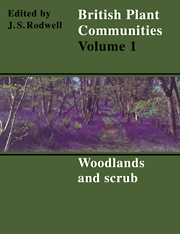Book contents
- Frontmatter
- Contents
- List of Figures
- Foreword
- Preface and Acknowledgements
- Preamble
- General Introduction
- Woodlands and Scrub
- Introduction to Woodlands and Scrub
- Key To Woodlands and Scrub
- Community Descriptions
- W1 Salix Cinerea-Galium Palustre woodland
- W2 Salix Cinerea-Betula Pubescens-Phragmites Australis Woodland
- W3 Salix Pentandra-Carex Rostrata Woodland
- W4 Betula Pubescens-Molinia Caerulea Woodland
- W5 Alnus Glutinosa-Carex Paniculata Woodland
- W6 Alnus Glutinosa-Urtica Jzozca Woodland
- W7 Ainus Glutinosa-Fraxinus Excelsior-Lysimachia Nemorum Woodland
- W8 Fraxinus Excelsior-Acer Campestre-Mercurialis Perennis Woodland
- W9 Fraxinus Excelsior-Sorbus Aucuparia-Mercurialis Perennis Woodland
- W10 Quereus Robur-Pteridium Aquilinum-Rubus Fruticosus Woodland
- W11 Quereus Petraea-Betula Pubescens-Oxalis Acetosella Woodland
- W12 Fagus Sylvatica-Mercurialis Perennis Woodland
- W13 Taxus Baccata Woodland
- W14 Fagus Sylvatica-Rubus Fruticosus Woodland
- W15 Fagus Sylvatica-Deschampsia Flexuosa Woodland
- W16 Quereus spp.-Betula spp.-Deschampsia Flexuosa Woodland
- W17 Quereus Petraea-Betula Pubescens-Dicranum Majus Woodland
- W18 Pinus Sylvestris-Hylocomium Splendens Woodland
- W19 Juniperus Communis Ssp. Communis-Oxalis Acetosella Woodland
- W20 Salix Lapponum-Luzula Sylvatica Scrub
- W21 Crataegus monogyna-Hedera helix scrub
- W22 Prunus Spinosa-Rubus Fruticosus Scrub
- W23 Ulex Europaeus-Rubus Fruticosus Scrub
- W24 Rubus Fruticosus-Holcus Lanatus Underscrub
- W25 Pteridium Aquilinum-Rubus Fruticosus Underscrub
- Index of Synonyms to Woodlands and Scrub
- Index of Species in Woodlands and Scrub
- Bibliography
W15 - Fagus Sylvatica-Deschampsia Flexuosa Woodland
Published online by Cambridge University Press: 04 July 2020
- Frontmatter
- Contents
- List of Figures
- Foreword
- Preface and Acknowledgements
- Preamble
- General Introduction
- Woodlands and Scrub
- Introduction to Woodlands and Scrub
- Key To Woodlands and Scrub
- Community Descriptions
- W1 Salix Cinerea-Galium Palustre woodland
- W2 Salix Cinerea-Betula Pubescens-Phragmites Australis Woodland
- W3 Salix Pentandra-Carex Rostrata Woodland
- W4 Betula Pubescens-Molinia Caerulea Woodland
- W5 Alnus Glutinosa-Carex Paniculata Woodland
- W6 Alnus Glutinosa-Urtica Jzozca Woodland
- W7 Ainus Glutinosa-Fraxinus Excelsior-Lysimachia Nemorum Woodland
- W8 Fraxinus Excelsior-Acer Campestre-Mercurialis Perennis Woodland
- W9 Fraxinus Excelsior-Sorbus Aucuparia-Mercurialis Perennis Woodland
- W10 Quereus Robur-Pteridium Aquilinum-Rubus Fruticosus Woodland
- W11 Quereus Petraea-Betula Pubescens-Oxalis Acetosella Woodland
- W12 Fagus Sylvatica-Mercurialis Perennis Woodland
- W13 Taxus Baccata Woodland
- W14 Fagus Sylvatica-Rubus Fruticosus Woodland
- W15 Fagus Sylvatica-Deschampsia Flexuosa Woodland
- W16 Quereus spp.-Betula spp.-Deschampsia Flexuosa Woodland
- W17 Quereus Petraea-Betula Pubescens-Dicranum Majus Woodland
- W18 Pinus Sylvestris-Hylocomium Splendens Woodland
- W19 Juniperus Communis Ssp. Communis-Oxalis Acetosella Woodland
- W20 Salix Lapponum-Luzula Sylvatica Scrub
- W21 Crataegus monogyna-Hedera helix scrub
- W22 Prunus Spinosa-Rubus Fruticosus Scrub
- W23 Ulex Europaeus-Rubus Fruticosus Scrub
- W24 Rubus Fruticosus-Holcus Lanatus Underscrub
- W25 Pteridium Aquilinum-Rubus Fruticosus Underscrub
- Index of Synonyms to Woodlands and Scrub
- Index of Species in Woodlands and Scrub
- Bibliography
Summary
Synonymy
Chalk plateau beechwoods (c) Watt & Tansley 1930; Beechwoods on heath Watt & Tansley 1930; Beech associes, sere C Watt 19346; Beech consociation, sere C Watt 19346; Fagetum arenicolumlericetosum Tansley 1939; Beech-Oak-Birch Association, types 1 & 2 p.p. McNeill 1961; Beech-oak-holly woods Peterken & Tubbs 1965 p.p.; Beechwood Rackham 1980 p.p.; Beech stand types 8A & 8B Peterken 1981; Woodland plot type 17 Bunce 1982 p.p.
Constant species
Fagus sylvatica (Deschampsia flexuosa, Pteridium aquilinum, Dicranella heteromalla, Mnium hornum).
Physiognomy
The Fagus sylvatica-Deschampsia flexuosa woodland is the third of the forest types in which beech attains great pre-eminence in Britain but, as in its counterpart at the opposite edaphic extreme, the Fagus-Mercurialis woodland, beech does not make such generally good growth here, nor is it so overwhelmingly dominant, as in the Fagus-Rubus woodland. Thus, though beech is the most frequent tree in this community as a whole and often the most abundant component of individual stands, the mean canopy height is usually less than 20 m and the trees are quite commonly of manifestly poor quality, sometimes growing crookedly and generally attaining no more than quality class III (Watt 19346, Brown 1953, McNeill 1961, Rackham 1980). Coppiced stands are very rare (though they may have been more abundant in the past) and the usual structure is high forest, though signs of a variety of different treatments are widespread. Some tracts are obviously of planted origin, with morphologically-similar trees disposed in more or less even spacings (Watt 19346, Brown 1953, 1964) and, in the Chilterns, where this community is represented among the plateau woodlands, a preponderance of smaller, poorly-grown individuals sometimes indicates long treatment under the selection system (Brown 1953,1964, Peterken 1981). Other stands have been treated as woodpasture, as in Burnham Beeches (Tansley 1939), in Epping Forest (Paulson 1926, Tansley 1939) and parts of the New Forest (Peterken & Tubbs 1965, Tubbs 1968) and, in some of these places, magnificent pollard beeches survive. Even in stands which have been more actively managed, it is sometimes still possible to discern variation between individual trees and their groupings which can give some clue of the original development of the woodland by sub-spontaneous invasion with muchbranched pioneers and unbranched followers (Watt 19346) or clumped age-classes related to waves of colonisation (Peterken & Tubbs 1965, Tubbs 1968).
- Type
- Chapter
- Information
- British Plant Communities , pp. 251 - 262Publisher: Cambridge University PressPrint publication year: 1991

